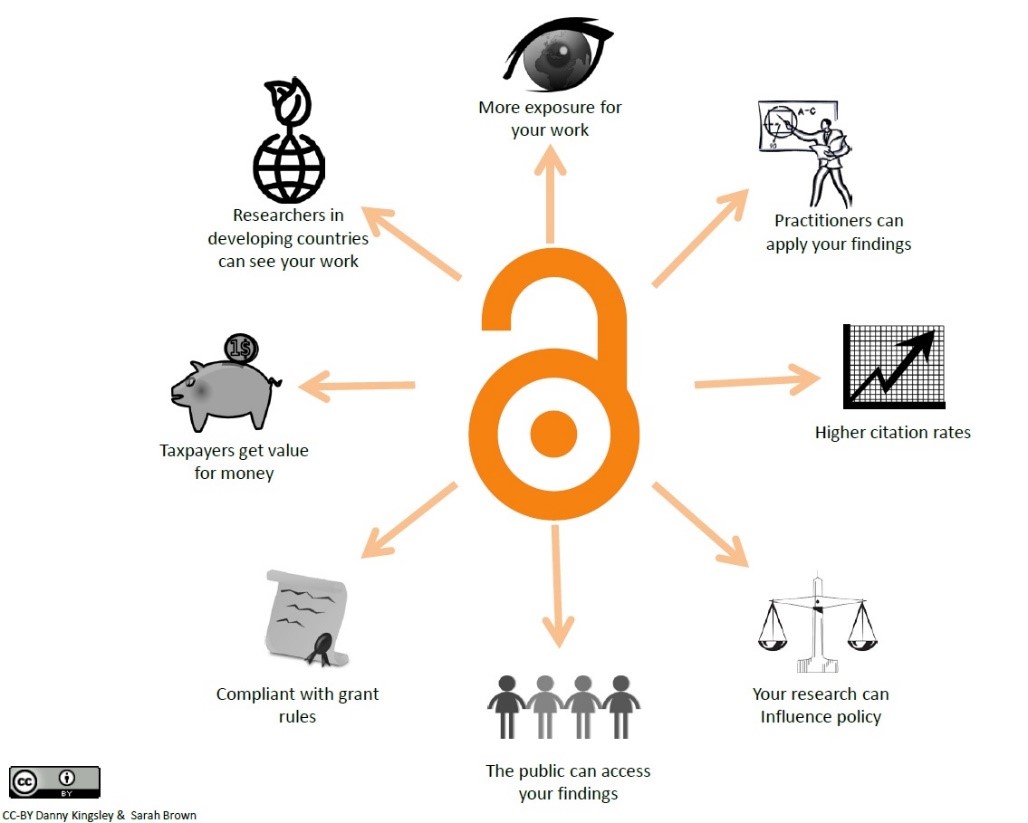What is Open Access?
“Open Access” research is free to read online and free to re-use (with some restrictions). The majority of research carried out at universities is publicly funded and making findings available via Open Access means that everyone can access research findings. Open Access research also has clear re-use rights that allow people to build upon and develop research.
Benefits of Open Access

Making your research Open Access benefits you, your readers, and wider society.
For you as a researcher, making your research Open Access means more people can read your research which could lead to increased citations and collaborations.
Open Access gives those outside of academia greater access to research including practitioners, policymakers, charities, small businesses and independent researchers. Smaller institutions and those in developing countries can also access research that they otherwise would not have been able to afford. To put this into context, if you are not a member of an institution that is able to pay subscription charges, to purchase a single journal article will usually cost around £25.
There are two main types of Open Access: Green Open Access and Gold Open Access.
Green Open Access
Sharing your research via an institutional or subject repository is known as Green Open Access. Research outputs are published under the subscription model where a cost is charged for access, but a version is also made available for free in an online repository after an embargo period specified by the publisher. Embargo periods differ depending on the publisher but are typically between 6 and 24 months.
Publishers and journals vary in which version of the paper they allow to be shared via a repository but usually, it is the Author Accepted Version (the version that has been accepted following peer review, but not yet published).
You can search for further information on specific journal policies on Author Accepted Versions using the Open Policy FInder tool, but remember too that as a member of staff your work will be covered by our Research Publications and Copyright Policy.
Gold Open Access
Gold Open Access research is made freely available immediately upon publication on the publisher's website. Usually, the publisher will charge a fee to make research available in this way. This fee is typically known as an article processing charge (APC) and can range in cost from as little as £200 to as much as £5000. Fees can usually be paid by your funder or institution. You should check before committing to a journal that funding is available.
There are two different types of academic journals when it comes to Gold Open Access:-
- Fully Gold journals only publish Open Access papers and therefore a fee must be paid to publish.
- Hybrid journals give you a choice of whether you want to publish via Gold Open Access or via the subscription model. A fee will be applicable if you choose the Gold Open Access route.
We have also entered into what is known as “transformative” deals with many publishers. These deals aim to shift the charges from paying for access to read journals over to paying for Open Access publishing instead. Where we have a deal like this in place with a publisher, our researchers can usually publish Open Access with them for no additional cost. For details of which publishers this applies to please see our Publisher Memberships and Agreements page.
Plan S
An international consortium of research funders, known as cOAlition S, launched Plan S in September 2018 to accelerate the move to full and immediate Open Access to research. The plan contains ten principles that funders who have signed up to the plan will incorporate in their own Open Access policies. More information can be found on the Plan S website.
UKRI, the Wellcome Trust and other funders that we work with support Plan S and their Open Access policies will therefore be changing. More information can be found on our Policies page.